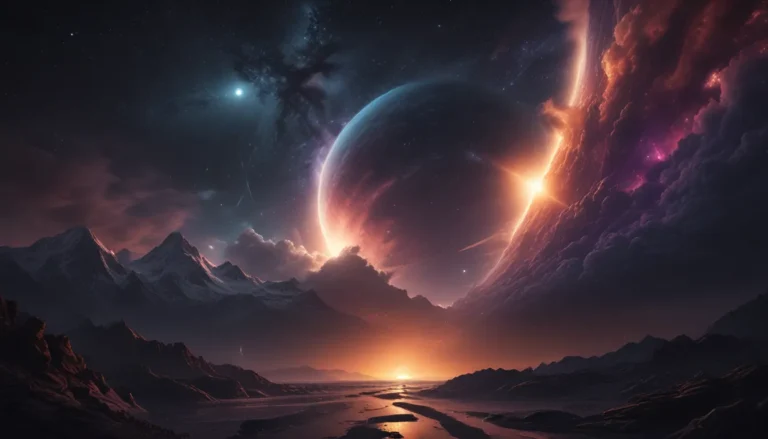The pictures we use in our articles might not show exactly what the words say. We choose these pictures to make you interested in reading more. The pictures work together with the words but don’t take their place. The words still tell you the important facts.
Welcome to the captivating world of the Milky Way, our cosmic galaxy that has fascinated humanity for centuries. Stretching over 100,000 light-years in diameter, it is a vast cosmic structure teeming with billions of stars, dust, and gas. As we gaze at the shimmering band of stars in the night sky, we may overlook the intricate complexity and beauty hidden within our galactic home.
Exploring the Galactic Marvel: The Milky Way
The Milky Way is a Spinning Spiral Galaxy
Envisioned as a large barred spiral galaxy, the Milky Way spans approximately 100,000 light-years in diameter. It comprises billions of stars, gas, dust, and dark matter intricately woven together, creating a spectacular sight in the night sky.
A Member of the Local Group
The Milky Way is part of the Local Group, a cluster of around 54 galaxies gravitationally bound to each other. The Andromeda Galaxy, the largest member of the Local Group, is on a collision course with the Milky Way in about 4.5 billion years.
Sagittarius A*: The Supermassive Black Hole at the Core
At the heart of the Milky Way lies a supermassive black hole named Sagittarius A*. This black hole, with a mass equivalent to about 4 million suns, plays a pivotal role in shaping the galaxy’s structure and dynamics.
Billions of Stars Illuminate the Night Sky
The Milky Way is estimated to host between 200 billion to 400 billion stars, creating the mesmerizing band of light that graces our night sky.
Constant Movement and Rotation
Far from being stationary, the Milky Way is in constant motion through space, rotating at about 168 miles per second near its center.
Spiraling Arms Create Cosmic Vistas
Featuring several spiral arms filled with gas, dust, and young stars, the Milky Way offers breathtaking cosmic vistas that reveal the beauty and complexity of our galaxy.
An Ancient Cosmic Entity
Scientists estimate that the Milky Way formed around 13.6 billion years ago, shortly after the Big Bang, and has been evolving ever since.
Our Home in the Cosmos
Earth finds its place in the Milky Way galaxy, specifically in one of its outer arms known as the Orion Arm. Our solar system is a mere dot within this vast cosmic expanse.
Potential for Habitable Worlds
With billions of stars in the Milky Way, experts believe that there may be billions of planets capable of sustaining life, sparking ongoing scientific quests for extraterrestrial life within our galaxy.
Interactions with Other Galaxies
Far from being isolated, the Milky Way frequently interacts with other galaxies through gravitational forces, leading to the formation of new stars and the rearrangement of galactic structures.
Enigmatic Halo of Dark Matter
Surrounding the visible disk of the Milky Way is a halo of dark matter, an invisible substance that exerts gravitational influence on visible matter, shaping the galaxy’s structure and dynamics.
Embark on a mesmerizing journey through the intricate tapestry of the Milky Way, a cosmic wonderland waiting to be explored and understood.
Delving Deeper: Milky Way Unveiled
As we unravel the mysteries of the Milky Way, we encounter a universe filled with wonders that challenge our comprehension of the cosmos. From the enigmatic supermassive black hole at its core to the tantalizing prospect of habitable planets, each discovery brings us closer to unraveling the secrets of our galactic abode.
So, the next time you gaze at the night sky and behold the band of stars above, remember that the Milky Way is not merely a celestial spectacle—it is a cosmic enigma brimming with hidden treasures.
FAQs: Unveiling Milky Way’s Secrets
- How did the Milky Way get its name?
The Milky Way received its name due to its appearance as a hazy band of light in the night sky, reminiscent of spilled milk. The term “Milky Way” originates from the Latin phrase “via lactea,” meaning “milky road.”
- How large is the Milky Way?
Spanning approximately 100,000 light-years in diameter, the Milky Way boasts billions of stars, gas, dust, and celestial objects that form its grand spiral structure.
- Is the Milky Way the sole galaxy in the universe?
No, the Milky Way is just one of billions of galaxies in the observable universe. It forms part of the Local Group, encompassing around 54 other galaxies, and belongs to the larger Virgo Supercluster.
- Does the Milky Way harbor black holes?
Indeed! The Milky Way is home to Sagittarius A*, a supermassive black hole at its center with a mass millions of times that of our sun.
- Can we observe the Milky Way from Earth?
Yes, we can catch a glimpse of a portion of the Milky Way from Earth. However, urban light pollution often obscures the view. For optimal stargazing, head to remote, dark sky locations with minimal light pollution.
Conclusion: Cosmic Wonders Await
Venture into the depths of the Milky Way, where mysteries abound and cosmic marvels beckon. From the enigmatic Galactic Center to the alluring Galactic Halo, a realm of ancient stars and elusive dark matter awaits exploration.
Our commitment to delivering engaging and factual content ensures that you embark on a journey of discovery with confidence. Trust in our dedication to authenticity as you uncover the wonders of the Milky Way and the vast cosmos beyond.
Dive into the captivating cosmos of the Milky Way, where each revelation unveils new horizons of discovery and wonder. Embark on an odyssey through the cosmic enigma that is the Milky Way, a cosmic conundrum waiting to be unraveled.
Unravel the mysteries of our galactic home and behold the wonders of the Milky Way, where cosmic secrets lie hidden in the depths of space.






